
Critical moment: why are Russian forces advancing faster, and can Ukraine hold them back?
In 2024, the war in Ukraine entered a complex, possibly decisive phase, marked by intensified Russian offensives and their relentless advance in the east
Content
- Ukraine loses territory larger than Luxembourg in 11 months
- Shift in Russian tactics: from 'Kyiv in three days' to methodical 'meat grinder' assaults
- Lack of troops leads to declining morale and loss of territory
- Challenging situation, but Ukrainian army effectively uses maneuver defense
- Resilience, possible counteroffensive, and geopolitical support
Espreso will explain how much territory Russia has captured, how it managed to turn the situation on the front in its favor, and whether Ukraine has the means to stop the occupying Russian forces in the near future.
Ukraine loses territory larger than Luxembourg in 11 months
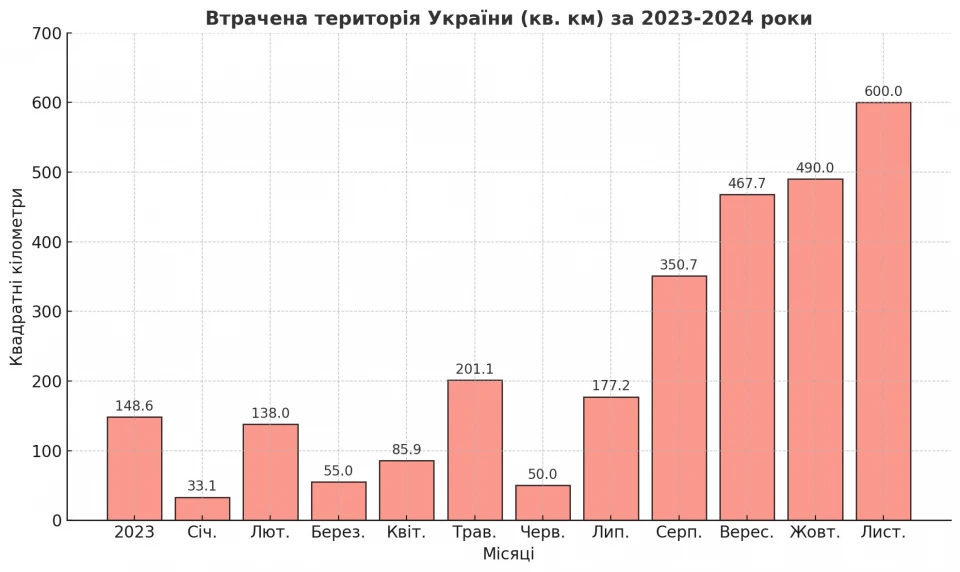
The graphic illustrates Ukraine's territorial losses from 2023 to 2024, with the horizontal bar representing the entire year of 2023 and the months of 2024 from January to November. The vertical line indicates the number of square kilometers lost.
Despite colossal losses, Russia continues to make regular territorial gains, mostly in the Donetsk region, but also in the Kharkiv region. In the first half of this year, Russia managed to capture 50-200 square kilometers per month, but in August, this number rose to 351, and in September, it reached 468. According to the UA War Infographics project, Russia captured only about 150 square kilometers throughout 2023.
The situation has worsened in the past two months. In October, according to the DeepState OSINT project, Russia seized 490 square kilometers, and in November, as reported by Reuters, the figure rose to over 600. In total, this amounts to the combined territory of Kyiv and Kharkiv.
If we add up all the available figures, over 11 months, Russian forces have occupied more than 2,700 square kilometers of Ukraine. To put this into perspective, the area of Chernivtsi region, the smallest in Ukraine, is 8,100 square kilometers, so 2,700 square kilometers is about a third of Bukovina. This is roughly the size of Luxembourg.
According to DeepState, since 2014, Russia has temporarily occupied a total of 111,340 square kilometers, or 18.44% of Ukraine. Before February 24, 2022, 43,969 square kilometers were not under the control of the Ukrainian government, meaning that during the full-scale war, Russia has occupied about 67,400 square kilometers of Ukrainian land, with 95-96% of this gained in 2022, and only 4% in 2024.
The acceleration of Russian advances, the fastest since the beginning of the full-scale war, indicates the Kremlin’s desire to occupy all of the Donetsk region, especially before January 20, when Donald Trump will officially take office in the White House, having promised to end the war within 24 hours through coercive diplomacy.
Shift in Russian tactics: from 'Kyiv in three days' to methodical 'meat grinder' assaults
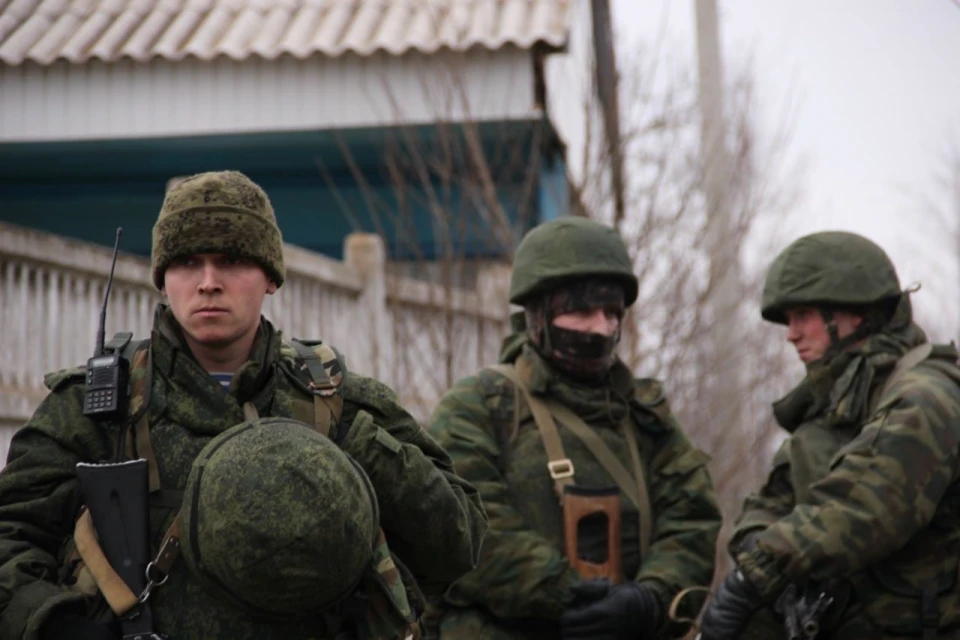
The Ukrainian army has been heroically defending against a colossal military force for almost three years, which continues to rank as the second-largest army in the world according to the Global Firepower index.
At the start of the full-scale war, Ukrainians demonstrated that even without enough weapons and modern equipment, Russia could be stopped, especially if they sent their overwhelming forces in long columns to break through against motivated and mobile soldier groups. This is why 2022 was successful for the Ukrainian Armed Forces – counteroffensives in Kyiv, Kharkiv, and Kherson regions are proof of that. Why did they succeed? First, due to poor Russian planning and the Kremlin’s mistaken belief in “taking Kyiv in three days.” Second, it was helped by the national-patriotic fervor of Ukrainians, who flocked to the military, while civilians were ready to assist in every way possible. Of course, we must not forget diplomacy – Ukraine united the democratic world around its cause, and the support of allies made it possible to continue the war until victory.
However, 2023 was a significantly different year. Over the year, Russian command revised its expectations of a quick victory and began planning a different, more long-term and localized strategy, methodically leveraging its superiority in artillery and personnel, seeking weaknesses in Ukraine’s defense, while also fortifying and mining the territories it had already captured. The so-called “meat assaults,” where Russian soldiers were massed and sent under Ukrainian fire, machine guns, tanks, and drones, began to show results.
This was especially evident in the Battle of Bakhmut, when in May 2023, after nine months of fierce fighting, the Ukrainian Armed Forces were forced to withdraw from this district center in Donetsk region. Specifically, the Wagner Group gathered tens of thousands of soldiers from among convicts and, through a "human meat grinder," managed to break through Ukraine’s defenses.
In the summer of 2023, Ukraine had the opportunity to respond with its counteroffensive, which, however, did not yield the desired results. The liberation of southern Zaporizhzhia and Kherson regions and advancing toward Crimea and the Azov Sea were not achieved. Instead, many resources were lost, and, most importantly, people.
Despite periodic clashes, by the fall of last year, it seemed that the front had reached a stalemate, as noted by the then-Commander-in-Chief of the Ukrainian Armed Forces, Valerii Zaluzhnyi, who called for finding "new gunpowder"—new technologies to achieve the desired result in the war. Neither Ukrainian nor Russian forces could make significant changes on the battlefield.
However, it turned out to be a calm before the storm, as at the end of 2023, the assault on Avdiivka began, coinciding with two major problems Ukraine was facing. The first was the delay in the U.S. policy, which postponed the allocation of $60 billion in aid for six months, causing a catastrophic shortage of ammunition and military equipment for the Ukrainian Armed Forces. The second issue was mobilization and a lack of personnel, with the need for an additional 500,000 soldiers due to losses and the necessity for rotation.
As a result, in February 2024, Russians captured Avdiivka. In April, the U.S. finally allocated the funds, and in May, the parliament changed the mobilization laws, but the daily advance of Russian forces did not stop; it only intensified. Why?
Lack of troops leads to declining morale and loss of territory
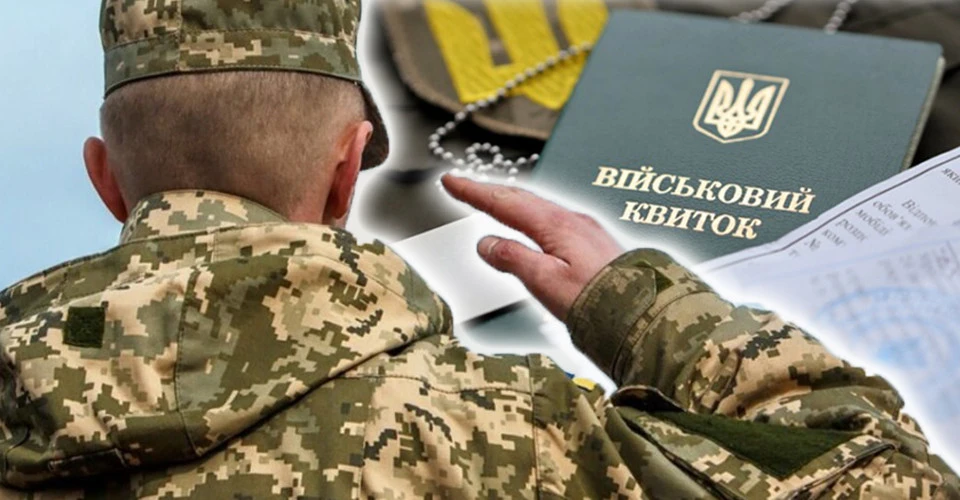
The first thing to understand is that a war of such scale and intensity sooner or later leads to resource problems. And Ukraine has significantly fewer resources than Russia, especially people.
Although neither Ukraine nor Russia disclose exact data on military casualties, as reported by The Wall Street Journal in September, the combined losses of both countries have already reached one million people. According to recent data from The Economist, over nearly three years of a full-scale invasion, Ukraine may have lost between 60,000 to 100,000 soldiers killed, with around 400,000 likely wounded (one in every 20 combat-age men is either dead or severely injured and unable to continue fighting). Meanwhile, Russia's army has lost about 200,000 killed and approximately 400,000 wounded.
The number of soldiers killed in both countries is quickly approaching the losses the United States suffered in World War II, writes the outlet.
Given such massive figures, it is no surprise that Ukraine has been the first to face a critical shortage of personnel on the front lines. Since Russia's population is roughly four times larger than Ukraine's, its mobilization resources are significantly greater. After the uproar surrounding mobilization in the fall of 2022, when young people fled abroad in mass, Russia shifted to a "quiet mobilization" tactic, recruiting men from rural areas with promises of sky-high salaries. Additionally, thanks to the close relationship between Vladimir Putin and Kim Jong Un, thousands of North Korean soldiers have been recruited to fight for Russia.
In Ukraine, mobilization has undergone a difficult process: from overcrowded territorial recruitment centers in the early days and weeks of the full-scale war to gaining a controversial reputation due to cases of forced recruitment, which became known as "busification." Scandals involving military commissars and military-medical commissions (VSS) who, for money, removed people from the military register or issued disability certificates led to a loss of trust in the state's method of replenishing the military ranks.
With significant delays, in May 2024, lawmakers amended the mobilization legislation to allow men to easily update their data, but most did not do so, prompting many experts to speak of a failure in mobilization policy.
"We have more than 6 million conscripts who are not showing up, not updating their data. They prefer to pay fines and hide while other guys are defending their lives, their families, children. What law do we need to pass to motivate these 6 million to come in accordance with the current legislation, register, and update their information?" said MP Oleksandr Fediyenko in October.
It is also important to remember that many men left Ukraine, both legally and illegally. Border guards and police report daily arrests of men trying to cross the border without permission. The Tisa River has become known as the "river of death" because about 40 men are known to have attempted to cross it, only to be swept away by the turbulent waters. In February of this year, the UN's International Organization for Migration reported that 6.5 million Ukrainians have refugee status and are living abroad, with an estimated 700,000 of them being men of conscription age.
Western officials, who were consistently delayed in sending Ukraine the necessary weapons, are now openly stating that the mobilization issue is the main reason for Ukraine's setbacks on the battlefield.
“Have we seen a marked difference since we have provided tanks to Ukraine in terms of the battlefield? Similarly, on F-16s, have we seen a marked difference? Our view has been that there's not one weapon system that makes a difference in this battle. It's about manpower, and Ukraine needs to do more, in our view, to firm up its lines in terms of the number of forces it has on the front lines,” said Jake Sullivan, U.S. National Security Advisor.
Reuters reports that U.S. officials have been urging Ukraine for months to lower the military draft age to 18. According to the Associated Press, due to a shortage of personnel, the Ukrainian Armed Forces may soon withdraw from the Kursk region. It is suggested that Ukraine plans to mobilize about 160,000 additional troops, but the U.S. administration believes that even more may be needed. However, the Office of President Zelensky responded that the issue is not only about recruiting new soldiers but also about Ukraine's inability to equip the troops it is currently mobilizing, meaning the lack of sufficient weapons.
In any case, the staffing problem, lack of rotations, and, importantly, the absence of fixed service terms have led to a decline in morale among some soldiers and an increase in AWOL (unauthorized absences). In October, MP Anna Skorokhod stated that 100,000 soldiers were in AWOL status (about 10% of all mobilized). Some soldiers even began to leave in a show of protest to draw attention to the problem of "eternal service."
Challenging situation, but Ukrainian army effectively uses maneuver defense
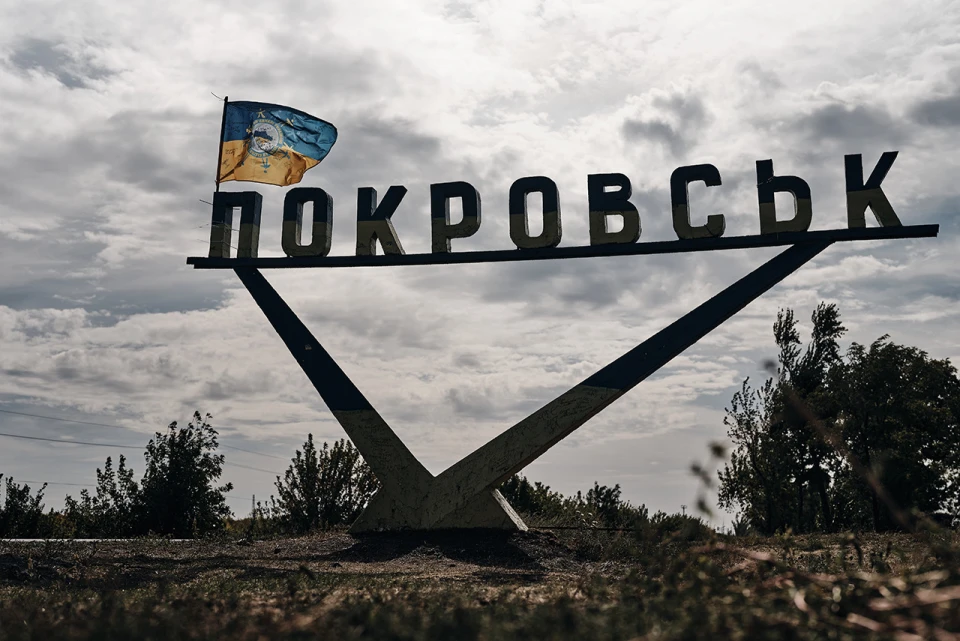
As a result, there is a catastrophic shortage of infantry to stop the constant Russian attempts to advance further.
The most difficult situation is in the Pokrovsk sector, where Russia's strength in personnel is 5:1 compared to the Ukrainian Defense Forces. The Russians have already captured the southern stronghold of Vuhledar, are surrounding Kurakhove, storming Velyka Novosilka, and are only a few kilometers away from the strategically important Pokrovsk. The fall of Pokrovsk could open the road to the Dnipropetrovsk region. The situation is also critical in Chasiv Yar, as its capture would open the way to Kostiantynivka, and from there, the path to the last major cities in the Donetsk region under Ukrainian control – Kramatorsk and Sloviansk.
"Russian forces’ recent confirmed battlefield gains near Vuhledar and Velyka Novosilka demonstrate that the war in Ukraine is not stalemated. The frontline in Donetsk Oblast is becoming increasingly fluid as Russian forces recently have been advancing at a significantly quicker rate than they did in the entirety of 2023. Russian forces’ advances in southeastern Ukraine are largely the result of the discovery and tactical exploitation of vulnerabilities in Ukraine’s lines. Russian forces have been making gradual, tactical advances in southeastern Ukraine since Fall 2024," stated the Institute for the Study of War.
They add that Russian forces may soon capture Velyka Novosilka and advance toward the Ukrainian supply lines that lead to Dnipro and Zaporizhzhia regions.
As Ukrainian soldiers fighting near Pokrovsk told CNN, due to the severe shortage of personnel, they fear that Russia may make a significant breakthrough. They also complain that they have to use drones to strike advancing Russian units because there aren’t enough infantry to confront them.
The soldiers also told American journalists that in October, only 60 soldiers defended Selydove, which was quickly surrounded by Russian forces. Additionally, the newly arrived recruits are not prepared for combat, and commanders often make mistakes. The difficulty of the situation is also reflected in the order given to Ukrainian troops around Pokrovsk to fire on all unidentified targets, fearing Russian reconnaissance groups.
However, as Ukrainian experts note, there is no need for panic, as "the front is cracking, but it is not collapsing," as stated by Serhiy Zgurets’, CEO of the media and consulting company Defense Express, during an appearance on Espreso TV.
Although foreign media often portray the situation in the east as critical, military expert and director of the New Geopolitics Research Network, Mykhailo Samus, offers a different perspective. He emphasizes that Russian advances do not necessarily mean a breakthrough, as the Ukrainian army is successfully employing maneuver defense, inflicting significant losses on the Russian forces and buying time to strengthen positions. Samus points out that similar predictions about the "fall" of Ukrainian cities have been made before, but they did not come true. For example, the situation in the Kupyansk and Lyman sectors, which are critically important, remains stable. Ukrainian forces are holding positional defenses where possible and conducting maneuverable ones where it is more effective. Russian daily losses reach up to 1,500 personnel and dozens of units of equipment, indicating the effectiveness of Ukraine's defenses.
"War is a complex matter, and painting everything in negative colors doesn’t help. We’re all responsible for what’s happening at the front," the military expert noted.
If the Russians do manage to enter Pokrovsk, urban combat could slow them down, but the key question remains: will Russia halt their advance, and what could Ukraine do in response?
Resilience, possible counteroffensive, and geopolitical support
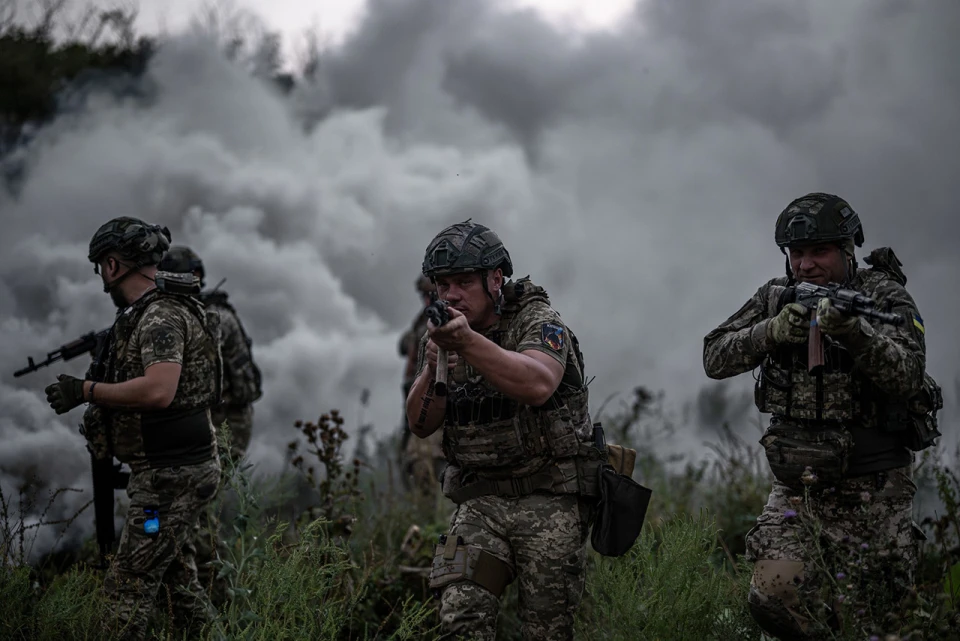
In 2024, Ukraine reminded the world that it is capable not only of defending itself but also of launching offensives. In August, Ukrainian forces managed to break through Russian defenses in the Kursk region, capturing 1,376 square kilometers of Russian territory, though currently, the Ukrainian Armed Forces hold about 800 of those square kilometers. As Commander-in-Chief of the Ukrainian Armed Forces, Oleksandr Syrskyi, recently stated, victory is impossible if Ukrainian forces only focus on defense. "We must seize the initiative and counterattack. We have the capability and will—where and when, you'll see."
Several key factors contribute to this optimism:
Winter weather. In the Donetsk region, frequent thaws during winter turn fields and roads into muddy, hard-to-navigate terrain, complicating the movement of armored vehicles and logistics. This forces Russian troops to advance primarily along main roads, which are well defended by the Ukrainian army. Snowfalls, fog, and shorter daylight hours limit visibility and hinder the use of drones, reconnaissance, and artillery fire adjustment. Additionally, soldiers face increased stress from the cold, reducing their mobility and morale.
Increased American assistance. As noted by The Washington Post, President Joe Biden is making every effort to strengthen Ukraine's position before Donald Trump takes office. Biden aims to utilize all the funds allocated by Congress to support Ukraine, with the U.S. sending new aid packages weekly. Restrictions have also been lifted, including the use of long-range missiles deep into Russian territory and the deployment of anti-personnel mines.
Reforms in the Armed Forces of Ukraine. The Ukrainian army is undergoing continuous internal reforms that are improving its capabilities. For instance, a recruitment-based model for replenishing the forces is becoming more widespread. Additionally, there is talk of introducing or reinstating military-operational tactical formations such as divisions or army corps, which could be more effective on the battlefield.
Trump's Position. Although Donald Trump has not yet officially presented his plan for resolving the Russia-Ukraine war, his nomination of retired General Keith Kellogg as a special envoy for conflict resolution speaks volumes. Previously, Kellogg proposed a peace plan that would condition continued U.S. arms supplies on Ukraine agreeing to peace negotiations with Russia. At the same time, the U.S. would warn Moscow of the consequences of refusing negotiations, including increased support for Kyiv and new sanctions. According to CNN, Trump's team is likely to push for a temporary ceasefire if negotiations between Russia and Ukraine occur. In such a case, any Russian offensive would be halted.
Europe's Position. While European allies of Ukraine remain uncertain about what to expect from Donald Trump, they assure continued support for Kyiv. Recently, the first Ukrainian brigade trained and equipped in France, comprising 4,500 troops, completed its training. Additionally, the EU Council extended the mandate of its training mission for Ukrainian soldiers by another two years. Germany and the United Kingdom have also recently provided new military aid packages and expressed readiness to continue such support.
Economic Struggles in Russia. Despite an appearance of stability and a shift to a wartime economy, Russia's economic position is increasingly eroding. The ruble has recently hit its lowest value since the war began, which will drive inflation and amplify public discontent. "Russia's war against Ukraine is eroding the foundations of its economy," British intelligence reports. Without a stable economy, the Kremlin will find it progressively harder to sustain the war effort.
Thus, despite challenges and emerging uncertainties, including shifts in U.S. political dynamics, Ukraine continues to showcase resilience and readiness not only to defend but also to counterattack, aiming to seize the strategic initiative and secure a stronger position for potential negotiations anticipated early next year.
As one high-level Ukrainian official told Ukrainska Pravda, the primary goal for Kyiv now is to "endure the winter and wait for Trump's inauguration, then negotiate from a stronger position."
- News












































